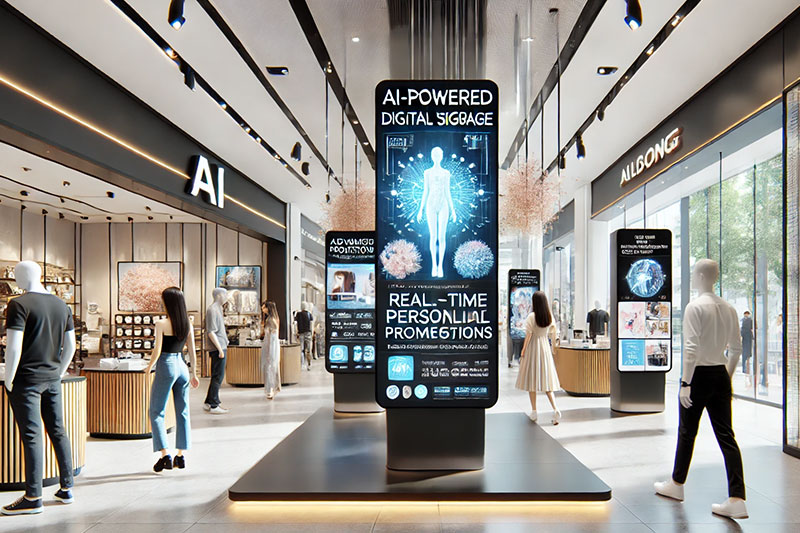In today’s competitive retail landscape, businesses are increasingly turning to AI-powered signage to enhance the effectiveness of their point-of-purchase (POP) displays. By leveraging artificial intelligence and data analytics, companies can create more engaging, personalized, and responsive in-store experiences that directly impact return on investment (ROI). This article delves into how AI-driven signage solutions are reshaping the industry and explores strategies that brands can adopt to maximize their ROI.
- Understanding the Power of AI in POP Displays
AI is transforming the signage industry by enabling data-driven decision-making that wasn’t possible with traditional displays. With AI technology, POP displays can now gather real-time data on customer interactions, monitor foot traffic, and analyze dwell time (how long a customer engages with the display). This information allows retailers to:
- Identify high-engagement areas in the store.
- Optimize content based on customer preferences.
- Improve signage placement for maximum visibility.
By continuously analyzing this data, businesses can fine-tune their displays to drive more meaningful customer interactions and ultimately boost sales performance.
- Real-Time Personalization: Tailoring Content to Audience Needs
One of the most effective applications of AI in signage is real-time personalization. AI algorithms can detect key details such as the age range, gender, and even mood of a customer. Based on this data, AI-powered displays can adjust the content shown to match the viewer’s profile, offering a highly personalized experience. For example:
- A younger audience might see promotions for trendy or limited-edition products.
- Older customers might be shown messages highlighting quality or durability.
This level of personalization not only captures attention but also increases the likelihood of a purchase, directly contributing to higher ROI.
- Data-Driven Content Optimization: Boosting Engagement Through AI Analytics
AI analytics can provide valuable insights into which types of content resonate most with customers. By monitoring metrics such as click-through rates on interactive screens or engagement duration for specific visuals, brands can identify the most effective content styles, formats, and messages. For example:
- If data reveals that video content has higher engagement than static images, brands might shift their focus to creating more video-based ads.
- If seasonal or holiday-themed content performs well, stores can adjust their displays to align with key events and promotions.
These insights help brands fine-tune their messaging and visual presentation, ensuring that every second of customer interaction with signage adds value, which translates to improved ROI.
- Predictive Analytics: Anticipating Customer Needs for Targeted Promotions
With the help of predictive analytics, AI-powered signage can forecast customer needs and preferences based on historical data and trends. For instance, if analytics show a pattern where a particular product becomes popular during certain times of the year, AI can automatically prioritize content that promotes this product when it’s most relevant. Examples include:
- Promoting umbrellas during the rainy season or highlighting warm clothing during winter.
- Running limited-time offers based on peak shopping hours for increased foot traffic.
Predictive analytics enable brands to create proactive and highly relevant displays, which not only engage customers more effectively but also lead to higher conversion rates.
- Heat Mapping and Foot Traffic Analysis: Optimizing Signage Placement
AI also allows for advanced heat mapping and foot traffic analysis within retail environments. This technology can track movement patterns, showing where customers tend to spend more time and which areas they frequently visit. With this data, businesses can strategically place their signage in high-traffic zones, where displays are likely to get maximum visibility. Effective placement of signage ensures that:
- More customers interact with the display, increasing the chances of conversion.
- Content is placed where it has the highest potential impact, maximizing the effectiveness of advertising spend.
By positioning displays in high-engagement areas, brands can achieve better ROI and use their resources more efficiently.
- Dynamic Content Adaptation: Responding to Market and Environmental Changes
AI-powered signage can adapt dynamically to real-world changes—from altering content based on weather conditions to responding to customer flow in real time. For example:
- If a store becomes unusually busy, AI can adjust content to highlight products that are easy to buy or quick to locate.
- On a hot day, displays might automatically switch to promoting cool beverages or summer clothing.
This adaptability helps retailers keep their messaging relevant and aligned with current conditions, ensuring that displays have the highest possible impact and are directly tied to customer needs, which is essential for optimizing ROI.
Conclusion: Embracing AI for a New Era of Smart Signage
As the demand for innovative, engaging POP displays grows, AI-powered signage is quickly becoming the standard for businesses seeking data-driven success. By using AI to personalize content, optimize placement, and adapt to real-time conditions, brands can create impactful displays that not only engage customers but also drive meaningful business outcomes. Embracing AI in signage allows retailers to maximize their investment, enhance customer experience, and stay ahead in a competitive market.
In 2024 and beyond, companies that leverage AI in their signage strategies will be well-positioned to capture customer attention and boost sales. With the data and insights provided by AI, POP displays can be transformed from simple advertisements into powerful tools for business growth.




